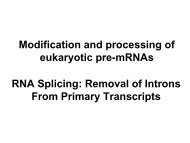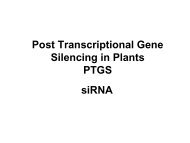You also want an ePaper? Increase the reach of your titles
YUMPU automatically turns print PDFs into web optimized ePapers that Google loves.
6. In silico approaches to alternative splicingWorkpackage description (month 37-54)Workpackage number 6 Start date or starting event: 0 monthParticipant id 5a 6 28 30 31Person months 8 44 8 8 8Objectives• Improved identification of known regulatory sequence motifs• Computational prediction of novel regulatory motifs• Computational prediction of regulatory proteins and RNAs• Investigation of correlations between promoter structure and alternative splicing• Investigations on the evolution of alternative splicing• Study evolution of gene structure.Description of work1.Generation of computational tools to assemble the information currently available on regulatory factor binding sites, aswell as visualization tools to screen genomic/pre-mRNA sequences for binding sites, with particular emphasis on clustersor regulatory elements.2. Develop algorithms for identification of novel regulatory motifs focusing on three aspects:Enrichment of / bias against sequence elements located in the proximity of weak or regulated splice sites.a.Enrichment of / bias against sequence elements in exons alternatively spliced in a tissue-specific fashion…b. Phylogenetic conservation of regulatory elements3. Identification of proteins with domains characteristic of splicing regulators and description of potential patterns ofexpression based on EST information.4. Exploration in silico of possible binding sites for micro-RNAs in alternatively spliced regions of pre-mRNAs, withparticular emphasis on genes of interest to the experimental groups of the Network.5. Exploration of possibilities for developing computational tools that correlate promoter structure with alternativesplicing events.6. Comparative analyses of the regulatory sequences and factors identified in points 2–4 for various species.Deliverables160 The Zavolan lab implemented a snoRNA-mRNA binding model, and applied this method to the prediction ofsnoRNA targets in mouse (in collaboration with Stamm). They will apply this method to other systems such as plants.These latter predictions will be tested by the Brown lab in the plant Arabidopsis thaliana. In addition they will improvethe quality of the miRNA target predictions, and will develop automated methods to update the predictions as moregenomes and transcripts become available. Finally, they will develop methods to relate changes in mRNA expression tochanges in the expression of miRNAs (month 42).162 The Ast lab will compare splice sites and splicing factors that bind these sites among the entire eukaryotic kingdom(in collaboration with Eyras). They will compare the evolution of genes, exon-intron structure, intron gain and loss, andthe effect of transposed elements in vertebrates and invertebrates (month 42).163 The Eyras group in collaboration with the Smith group will study the splicing regulation of introns in which thebranch site sequence located more than 100 nucleotides from the 3’ss. They will use comparative methods to extractpossible regulatory sequences and secondary structres that may be involved in the regulation. They will also identify thecases that are related to disease. In colaboration with the Ast group they will compare the splicing mechanism ineukaryotes. Using multiple eukaryotic species, they will compare the properties of protein factors and snRNAs involvedin splicing. They will investigate the role of the SR and hnRNPs proteins in the origin of regulated splicing (month 42).280 Continue to investigate putative mRNA targets of orphan snoRNAs (JBrown).281 Computational structural model of splicing regulators.282 Comparative analysis of the gene landscape.283 A unified browser for all known splicing regulatory sequences in exons and their flanking introns.256







